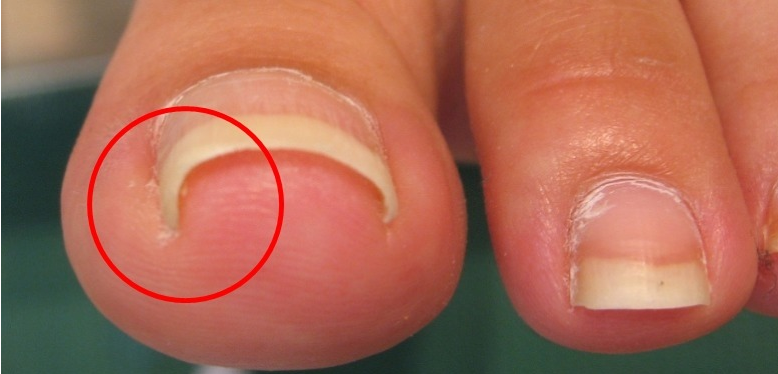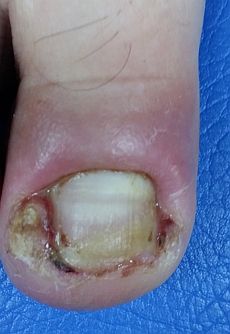medical term for infected ingrown toenail Ingrown toenail infection infected toenails
If you’ve ever experienced an ingrown toenail, you know just how painful and uncomfortable it can be. Ingrown toenails occur when the edge of the nail grows into the skin surrounding the nail. This can lead to redness, swelling, and even infection if left untreated. Fortunately, there are steps you can take to prevent and treat ingrown toenails. The first step in preventing ingrown toenails is to make sure you’re cutting your nails correctly. Always cut your nails straight across, rather than rounding the edges, to help prevent them from growing into the skin. You should also avoid cutting your nails too short, as this can also increase the risk of an ingrown toenail. If you do end up with an ingrown toenail, there are several things you can do to treat it at home. Soaking your foot in warm water for 15-20 minutes at a time can help to relieve pain and reduce swelling. You can also try gently massaging the skin around the nail to encourage it to grow away from the nail. In some cases, an ingrown toenail may become infected. Signs of an infection include redness, warmth, and pus around the affected nail. If you suspect an infection, it’s important to seek medical attention right away. Your doctor may prescribe antibiotics to help clear up the infection, or they may need to perform a minor surgical procedure to remove the ingrown portion of the nail. If you’re looking for ways to prevent ingrown toenails from occurring in the first place, there are several steps you can take. Wearing shoes that fit properly can help to prevent your toes from become crowded, which can increase the risk of ingrown toenails. You should also avoid wearing tight socks or stockings. Overall, ingrown toenails can be a painful and frustrating condition. However, with proper care and treatment, you can help to prevent them from occurring and reduce your risk of complications. If you’re experiencing symptoms of an ingrown toenail, don’t wait to seek medical attention. With the right care, you can get back on your feet and enjoy a pain-free life.
Image 1: Ingrown Toenail - Edmonds Medical Clinic
 Ingrown toenails occur when the edge of the nail grows into the skin surrounding the nail. This can lead to redness, swelling, and even infection if left untreated.
Ingrown toenails occur when the edge of the nail grows into the skin surrounding the nail. This can lead to redness, swelling, and even infection if left untreated.
Image 2: Ingrown Toenail Infection | CurveCorrect
 If you do end up with an ingrown toenail, there are several things you can do to treat it at home. Soaking your foot in warm water for 15-20 minutes at a time can help to relieve pain and reduce swelling.
If you do end up with an ingrown toenail, there are several things you can do to treat it at home. Soaking your foot in warm water for 15-20 minutes at a time can help to relieve pain and reduce swelling.
If you are searching about Ingrown Toenail: Treatment, Home Remedies, Prevention, Causes you’ve visit to the right place. We have 5 Pictures about Ingrown Toenail: Treatment, Home Remedies, Prevention, Causes like Ingrown Toenail - Edmonds Medical Clinic, Dr James Kang, Skin Specialist and General Practitioner and also Ingrown Toenail Infection | CurveCorrect. Here you go:
Ingrown Toenail: Treatment, Home Remedies, Prevention, Causes
 www.epainassist.comingrown toenail onychocryptosis remedies nail treat treatment toenails prevention causes medical proper foot signs feet avoid blood advertisement epainassist
www.epainassist.comingrown toenail onychocryptosis remedies nail treat treatment toenails prevention causes medical proper foot signs feet avoid blood advertisement epainassist
Ingrown Toenail - Edmonds Medical Clinic
 edmondsmedicalclinic.comingrown toenail
edmondsmedicalclinic.comingrown toenail
Ingrown Toenail Infection | CurveCorrect
 www.curvecorrect.comingrown toenail infection infected toenails
www.curvecorrect.comingrown toenail infection infected toenails
What Kind Of Doctor For Infected Finger
 thecartdesigns.blogspot.cominfected ingrown fingernail
thecartdesigns.blogspot.cominfected ingrown fingernail
Dr James Kang, Skin Specialist And General Practitioner
 www.myclinics.com.auingrown toenail
www.myclinics.com.auingrown toenail
Infected ingrown fingernail. Dr james kang, skin specialist and general practitioner. Ingrown toenail infection infected toenails